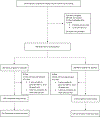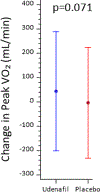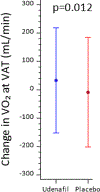Results of the FUEL Trial
- PMID: 31736357
- PMCID: PMC7042084
- DOI: 10.1161/CIRCULATIONAHA.119.044352
Results of the FUEL Trial
Erratum in
-
Correction to: Results of the FUEL Trial.Circulation. 2020 Jul 14;142(2):e31. doi: 10.1161/CIR.0000000000000882. Epub 2020 Jul 13. Circulation. 2020. PMID: 32658610 No abstract available.
Abstract
Background: The Fontan operation creates a total cavopulmonary connection, a circulation in which the importance of pulmonary vascular resistance is magnified. Over time, this circulation leads to deterioration of cardiovascular efficiency associated with a decline in exercise performance. Rigorous clinical trials aimed at improving physiology and guiding pharmacotherapy are lacking.
Methods: The FUEL trial (Fontan Udenafil Exercise Longitudinal) was a phase III clinical trial conducted at 30 centers. Participants were randomly assigned udenafil, 87.5 mg twice daily, or placebo in a 1:1 ratio. The primary outcome was the between-group difference in change in oxygen consumption at peak exercise. Secondary outcomes included between-group differences in changes in submaximal exercise at the ventilatory anaerobic threshold, the myocardial performance index, the natural log of the reactive hyperemia index, and serum brain-type natriuretic peptide.
Results: Between 2017 and 2019, 30 clinical sites in North America and the Republic of Korea randomly assigned 400 participants with Fontan physiology. The mean age at randomization was 15.5±2 years; 60% of participants were male, and 81% were white. All 400 participants were included in the primary analysis with imputation of the 26-week end point for 21 participants with missing data (11 randomly assigned to udenafil and 10 to placebo). Among randomly assigned participants, peak oxygen consumption increased by 44±245 mL/min (2.8%) in the udenafil group and declined by 3.7±228 mL/min (-0.2%) in the placebo group (P=0.071). Analysis at ventilatory anaerobic threshold demonstrated improvements in the udenafil group versus the placebo group in oxygen consumption (+33±185 [3.2%] versus -9±193 [-0.9%] mL/min, P=0.012), ventilatory equivalents of carbon dioxide (-0.8 versus -0.06, P=0.014), and work rate (+3.8 versus +0.34 W, P=0.021). There was no difference in change of myocardial performance index, the natural log of the reactive hyperemia index, or serum brain-type natriuretic peptide level.
Conclusions: In the FUEL trial, treatment with udenafil (87.5 mg twice daily) was not associated with an improvement in oxygen consumption at peak exercise but was associated with improvements in multiple measures of exercise performance at the ventilatory anaerobic threshold.
Clinical trial registration: URL: https://www.clinicaltrials.gov. Unique identifier: NCT02741115.
Keywords: Fontan procedure; exercise test; heart defects, congenital; phosphodiesterase 5 inhibitor.
Figures







Comment in
-
FUELing the Search for Medical Therapies in Late Fontan Failure.Circulation. 2020 Feb 25;141(8):652-654. doi: 10.1161/CIRCULATIONAHA.119.044512. Epub 2019 Nov 17. Circulation. 2020. PMID: 31736331 No abstract available.
-
Udenafil to FUEL exercise performance in individuals with Fontan physiology.Nat Rev Cardiol. 2020 Feb;17(2):72. doi: 10.1038/s41569-019-0324-9. Nat Rev Cardiol. 2020. PMID: 31797909 No abstract available.
-
Response by Goldberg et al to Letter Regarding Article, "Results of the FUEL Trial".Circulation. 2020 Jul 28;142(4):e40-e41. doi: 10.1161/CIRCULATIONAHA.120.048047. Epub 2020 Jul 27. Circulation. 2020. PMID: 32718249 Free PMC article. No abstract available.
-
Letter by Opotowsky et al Regarding Article, "Results of the FUEL Trial".Circulation. 2020 Jul 28;142(4):e38-e39. doi: 10.1161/CIRCULATIONAHA.119.045205. Epub 2020 Jul 27. Circulation. 2020. PMID: 32718251 No abstract available.
References
-
- Kreutzer G, Galindez E, Bono H, De Palma C and Laura JP. An operation for the correction of tricuspid atresia. The Journal of thoracic and cardiovascular surgery. 1973;66:613–21. - PubMed
-
- Gewillig M and Goldberg DJ. Failure of the fontan circulation. Heart Fail Clin. 2014;10:105–16. - PubMed
-
- Gewillig M, Brown SC, Eyskens B, Heying R, Ganame J, Budts W, La Gerche A and Gorenflo M. The Fontan circulation: who controls cardiac output? Interact Cardiovasc Thorac Surg. 2010;10:428–33. - PubMed
Publication types
MeSH terms
Substances
Associated data
Grants and funding
- UG1 HL135665/HL/NHLBI NIH HHS/United States
- UG1 HL135666/HL/NHLBI NIH HHS/United States
- U10 HL109818/HL/NHLBI NIH HHS/United States
- UG1 HL135680/HL/NHLBI NIH HHS/United States
- UG1 HL135646/HL/NHLBI NIH HHS/United States
- UG1 HL135683/HL/NHLBI NIH HHS/United States
- UG1 HL135685/HL/NHLBI NIH HHS/United States
- UG1 HL135689/HL/NHLBI NIH HHS/United States
- U10 HL068270/HL/NHLBI NIH HHS/United States
- KL2 TR002367/TR/NCATS NIH HHS/United States
- UM1 HL172717/HL/NHLBI NIH HHS/United States
- U24 HL135691/HL/NHLBI NIH HHS/United States
- UG1 HL135682/HL/NHLBI NIH HHS/United States
- U10 HL109673/HL/NHLBI NIH HHS/United States
- UG1 HL135678/HL/NHLBI NIH HHS/United States
LinkOut - more resources
Full Text Sources
Other Literature Sources
Medical

